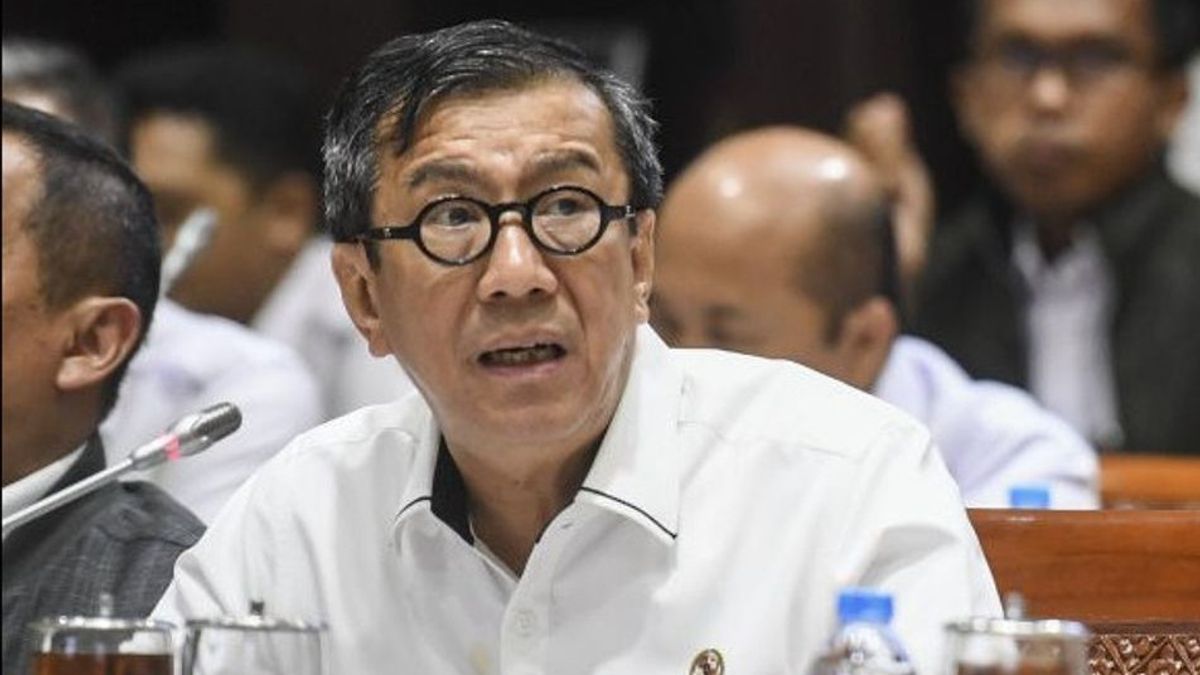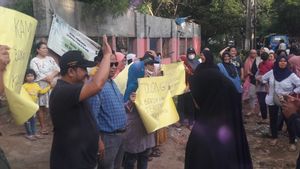JAKARTA - The Class I Tangerang Correctional Institution (Lapas) fire raised the fact that there are many problems with prisons. On the upstream side, imprisonment-oriented legal politics was again highlighted. Downstream, the management of prisons is no less problematic. All were acknowledged by the Minister of Law and Human Rights Yasonna Laoly, who called it a classic problem. If it's a classic, why hasn't it been completed? Maybe it's time for Yasonna to step down.
One fire. Killed 44 people. Raising a series of prison issues to the fore. Finally the police announced the results of the initial investigation. Puslabfor Polri has succeeded in finding the starting point of the fire. Allegations of electric short circuit are getting stronger. The general criminal investigation unit from the Regional Police and the Resort Police was also involved to explore the findings of a number of evidences at the crime scene that led to the alleged crime behind the fire.
"Another thing is because it is suspected that a criminal act has occurred, we are collecting evidence," said Director of General Crime Investigation of the Metro Jaya Police, Kombes Tubagus Ade Hidayat.
The evidence in question includes cables and some parts of the electrical installation. Apart from examining evidence, the police also examined the statements of a number of witnesses. They consist of guard officers, local residents, and prisoners. "Currently we are conducting (examination) 20 witnesses ... (Witness) Picket guards last night. Then the second is (residents) in the vicinity and the third is residents in the block who can still be questioned," said Tubagus.
The crime in question has not been specified. But most likely related elements of negligence or intentional. Regarding the emergence and spread of the fire, the police explained that the fire appeared in the ceiling in block C2. The fire spread and grew rapidly because of the flammable ceiling made of plywood. "From the TKP results, the hotspots originated from one point, and occurred above, behind the ceiling," said Tubagus.
Prison management problems
Previously, in a press conference yesterday, Wednesday, September 8, Minister of Law and Human Rights Yasonna Laoly said that there had never been any improvement in electrical installations in Tangerang prison since its establishment in 1972. The activities related to electricity were only limited to adding power.
"It's been 49 years since we haven't repaired the electrical installation. There is additional power, but the electrical installation is still the same," Yasonna said on that occasion.
Yasonna said he had ordered the Director General of Corrections, Reynhard Silitonga, to check the conditions of other prisons. According to Yasonna, fires caused by short circuits often occur in other prisons.
"Some have happened to us. Only a few small samples were caused by riots. But in general, old prisons are like this one. I asked the Director General of the electrical installation, Mr. Sesditjen to check it. I don't want it to happen again like this."
Another fact that was revealed from this fire incident was the delay in evacuating inmates by prison officials. According to Yasonna, the officers did not have time to evacuate all the inmates in Block C because the fire was rapidly spreading. When the fire burned, some of the occupants were still locked in the room. "Of course you ask why it is locked. Because the prison protocol must be locked. If it is not locked, it violates the protocol," said Yasonna.

University of Indonesia (UI) Fire Expert, Fatma Lestari highlighted this matter. Seeing the large number of victims, Fatma suspected that there were problems in the evacuation procedures and emergency organization in Tangerang prison.
This question must be pursued. What are the emergency systems and evacuation procedures in prisons? Walk? Fatma divides the fire emergency system into two: active and passive. In an active fire, the availability of fire extinguishers, sprinklers, and hydrants must be ensured to be available and functioning.
In the context of passive fires, evacuation procedures, including escape routes and safe zones are also mandatory. In addition, as a standard procedure, a trained emergency team is required to deal with fires at an early stage.
"Is there a procedure for evacuating so this prisoner is not trapped?" Fatma, in the Breaking News program on Metro TV. We have repeatedly tried to contact the Directorate General of Social Affairs of the Ministry of Law and Human Rights to answer this issue. However, until the article was published, there was no response.
This fire killed 44 inmates. According to Yasonna's explanation, 40 died on the spot. Another person died in hospital. And as of Thursday afternoon, September 9, three more people lost their lives in hospital treatment.
Overcapacity
Another is the issue of overcapacity, which is recognized by the Minister of Law and Human Rights Yasonna Laoly as a classic problem. According to information, Block C2 that burned was inhabited by 122 inmates. Meanwhile, Tangerang prison is filled with 2,072 inmates.
According to Yasonna, that number exceeds capacity by 245 percent. The capacity of the Tangerang prison should ideally only be inhabited by 600 inmates. Director of Amnesty International Indonesia Usman Hamid said this condition was worrying.
Not only because of the actual condition, but also because of the government's attitude which has not yet come to a resolution. In fact, this is an old issue, which again we explain has been acknowledged by Yasonna herself. So, this is not an ordinary fire but a violation of human rights.
“All prisoners have the right to be treated with humanity and dignity. Places of detention must provide adequate space, lighting, air and ventilation. An incident like this should never happen again. Limited prison capacity with an excessive number of occupants is the root of serious problems in the criminal justice system in Indonesia," Usman told VOI, Wednesday, September 8.
Last February, the Coalition for the Prevention of Torture (KuPP) released data on overcapacity in all Indonesian prisons. The KuPP is a coalition consisting of five institutions, namely Komnas HAM, the Witness and Victim Protection Agency (LPSK), Komnas Perempuan, the Indonesian Child Protection Commission (KPAI), and the Indonesian Ombudsman, in collaboration with the Directorate General of PAS.
According to data released by the Directorate General of PAS at that time, there were 252,384 assisted residents throughout Indonesia. Meanwhile, the capacity of prisons and remand centers is only 135,704. Director of Information Technology and Cooperation of the Directorate General of Corrections, Dodot Adikoeswanto, said that this condition caused the complexity of problems in prisons.
Stop imprisonment orientationDirector of Amnesty International Indonesia Usman Hamid said that one of the steps that the government must immediately take is to change the political orientation of the policy on handling minor crimes, including for cases of drug use and the ITE Law. "Free those who should never have been detained, including prisoners of conscience and those detained on the basis of the rubber articles in the ITE Law."
Detention and imprisonment of people with light crimes, drugs and the ITE Law, said Usman, only adds to the unnecessary burden of being in prison. Overcapacity is also seen by Usman as causing the failure to fulfill the Standard Minimum Rules on the Handling of Prisoners adopted by the United Nations. In the rules it is called:
All accommodation provided for use by detainees, in particular all sleeping accommodations, meets all health requirements taking due account of climatic conditions and, in particular, indoor air content, minimum floor area, lighting, heating and ventilation.
With all these conditions, Usman called this the right time for Yasonna to resign from the position of Menkum HAM. Not only Yasonna, various evidences of this failure also demanded the Director General of PAS Reynhard Silitonga to resign. "This is a serious problem for the human rights of many people, especially those who are victims and who are still in overcrowded prisons."
*Read other information about prisons or read other interesting articles from Yudhistira Mahabharata.
Other BERNASThe English, Chinese, Japanese, Arabic, and French versions are automatically generated by the AI. So there may still be inaccuracies in translating, please always see Indonesian as our main language. (system supported by DigitalSiber.id)








